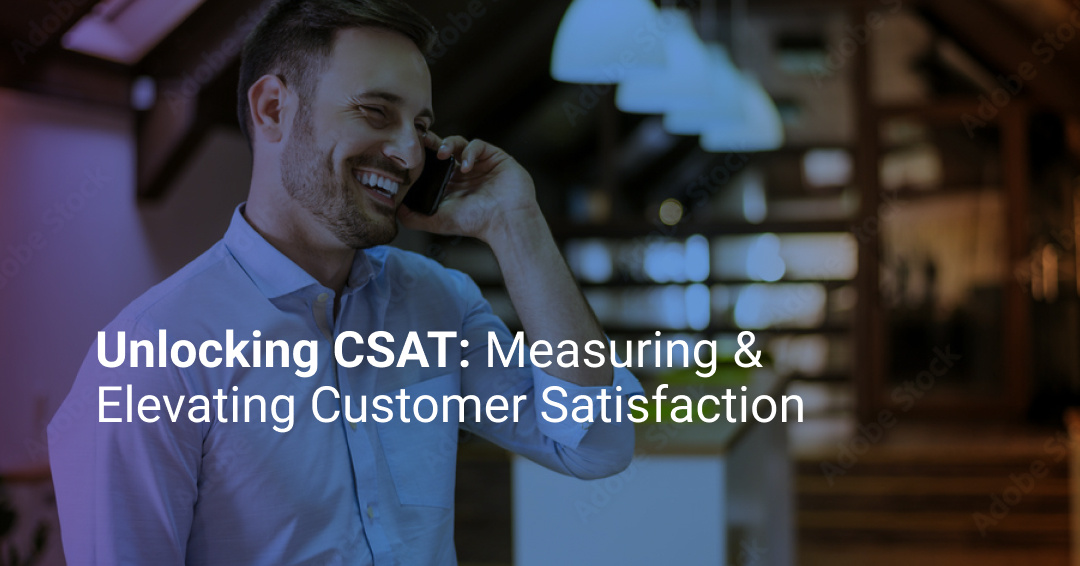12 Call Center Metrics You Should Be Using to Improve CX in 2025
Call center metrics are the most important performance indicators that monitor how effectively your call center is running. This includes anything...

A few signs may indicate that your business is ready to invest in contact center automation tools. Intelligent virtual agents (IVAs) solve today’s customer service challenges by providing personalized, real-time assistance. This blog guides contact center automation and uncovers three signs that it’s time to add an IVA.
Today's customers expect quick, personalized, and timely responses when they interact with businesses. Along with these shifting expectations, pandemic-related contact center challenges, such as staffing difficulties, increased call volumes, and more digital interactions, have introduced new customer service challenges.
Businesses turn to contact center automation tools to help ease challenges and meet customer expectations. However, not all automation tools are created equal. This blog covers different types of automation and details how intelligent virtual agents (IVAs) provide exceptional customer experiences. The post also explores customer service challenges and contact center challenges that could signify your business is ready to invest in contact center automation tools.
Contact center automation can look different for businesses, but at its core, it involves automating customer support and assistance capabilities to streamline processes for customers and agents.
Contact center automation tools are used to automate a range of tasks for businesses. These tools use computerized processes and artificial intelligence (AI), natural language processing (NLP), and machine learning.
There are also various contact center automation tools that can help businesses overcome their customer service challenges and contact center challenges. There are also different approaches and levels of automation. Contact center providers, for example, provide a more basic level of automation. Whereas a comprehensive communications and customer experience expert delivers true intelligent automation.
Understanding the differences between contact center technologies is essential when considering automation. Let’s explore further.
One category of contact center automation tools is workflow automation. Workflow automation allows you to connect your virtual agent to other integrated business systems, creating cross-system workflows. It delivers exceptional customer experiences and supplements the agent experiences by computing information and providing comprehensive data views.
Another category of contact center automation tools is response automation solutions. These tools effectively optimize customer service experiences because they allow a business to automate customer interactions.
Response automation solutions increase a contact center's capacity to handle higher call volumes, provide the quality service experiences customers expect, and offer personalized service. Automating these elements boosts customer experience and satisfaction.
Three common response automation tools include automatic call distribution (ACD), interactive voice response (IVR), and IVAs.
An ACD feature automatically routes calls according to a set of predetermined rules. Depending on the caller's needs, the technology routes calls to a specific department or individual agent based on those predetermined rules. An ACD is a component of IVR and IVA since it provides the activity of connecting once an IVR or IVA identifies the caller's needs. It also guides where the call goes next based on the predetermined rules. Many contact center providers allude to offering intelligent automation, but the solution is really ACD functionality.
IVR is a technology that lets callers navigate menu options using voice and touch-tone responses. It does not use AI. Automated phone systems with IVR software help callers navigate through resolution options and provide information based on the callers' actions. IVR software then routes the caller to a specific department or specialist. Some may consider an IVR to be a simple voicebot.
An IVA is an AI-enabled communication tool that generates personalized responses to users. These virtual agents are intuitive and can understand natural-language requests through natural language understanding or NLP. For the remainder of this blog, we'll focus specifically on IVAs, and how they mitigate customer service challenges.
However, with different types and levels of contact center automation tools, make sure that the provider you partner with offers the solution you're really looking for.

There are three key signs that your business is ready to adopt contact center automation tools, specifically an IVA:
Let's break these down further and explore potential contact center automation use cases.
There are a lot of customer service challenges facing today's contact centers that weren't present two to five years ago. These challenges aren't always easy to pinpoint but often have to do with the ability to meet customers' changing expectations.
For example, the inability to understand and meet changing needs makes it difficult to effectively address customer requests in the short term, which can negatively affect the business's reputation. Consumers expect quick, personalized, and timely responses when they interact with companies.
A recent Hubspot study shows that the most frustrating aspects of getting customer service help are waiting on hold, repeating yourself or information to different support representatives, slow response times, and not being able to resolve the issue online. Luckily, IVAs address all of these pain points.
Customers want their calls to be picked up immediately. Most digitally savvy customers also desire self-service capabilities, as they prefer to solve issues on their own and online if possible.
IVAs reduce customer wait times and increase first-touch resolution. These tools can answer calls immediately and provide contextual service, both of which are key KPIs in customer service. Customers feel more satisfied when these factors are improved.
Further, allowing for the automation of specific tasks can mitigate customer service challenges. This is because these virtual agents enable live agents to allocate time toward more complex customer needs, while the IVA assists as many customers as possible.
IVAs also provide self-service options where customers can resolve issues quickly and without needing to interact with a human agent. Self-service capabilities reduce hold times and the length of calls, which improves customer and agent experiences and saves both parties time and money.
Customers expect round-the-clock customer service capabilities. If a business is not leveraging contact center automation tools that offer 24/7 customer service, they'll receive swarms of customer calls at the start or end of business hours. These peak times result in all sorts of customer frustrations as they wait to receive support.
A virtual agent helps the business answer customer calls right away and even outside standard business hours. The virtual agent's ability to provide instant, convenient and simultaneous help to multiple customers reduces the frustration of long hold times or inconvenient business hours. The virtual agent also helps human agents optimize their regular work hours rather than being held up on simple support calls that an IVA could solve.
If you notice your contact center is struggling to keep up with calls during peak hours, that is a sign to consider an IVA. IVAs are not confined to the 9-5 workday, so customers can get support whenever they need it.
Customers want personalization. It's frustrating for customers to feel like support agents don't understand their needs or that the company doesn't have the resources available to address their unique problems. It's also time-consuming to repeat the issue to different agents, especially if the resolution time is not immediate.
IVAs can offer the level of personalization customers demand. These virtual agents use machine learning and other AI tools to intake information during interactions. The technology tracks, logs, and remembers critical details about the customer and incident. Then, if the IVA escalates the issue to a human agent, the agent can refer to the case log, only asking questions as needed, which mitigates potential customer service challenges. This provides personal service and eliminates repetition.
If you see these customer service challenges bubble in your contact center, it's time for contact center automation tools.

Contact center challenges evolve as a business grows and adapts to customers' changing expectations. Contact centers have undergone massive transformations, and the pandemic has heightened these changes with rising call volumes and staffing shortages.
These growing pains can introduce contact center challenges as companies account for gaps within their workforces and scale existing tools. However, many businesses have managed rapid growth and quickly adapted to newer digital spaces.
If existing contact center tools can't keep up with growth, are not digitally savvy, or allow automation, it's a sign to explore contact center automation tools. As mentioned above, IVAs reduce wait times for customers, track important customer case data, and free up human agents to handle more complex customer needs.
The combination of these factors minimizes average call length by 15-40%, resulting in faster resolutions and improved customer experiences. Because IVAs provide more intelligent reporting. A growing business can streamline training and communications between virtual agents, human agents, and customers.
In addition to providing self-service, 24/7 support, and personalization addressed above, sophisticated virtual agents offer channel flexibility, scalability, and cost savings to businesses.
IVAs give customers flexibility with the medium they use to interact with a business. Channel flexibility allows customers to call, text, or message a company and still receive fast, personalized, and quality resolutions.
With channel flexibility, customers can also choose how they receive certain notifications. For instance, a customer can select to receive text messages for reminders about bill payments and then calls for notifications about overdrafts or suspicious account activity.
Providing support and versatility across channels increases revenue-generating opportunities for businesses.
Legacy customer support tools are difficult to scale. When faced with increased calls and a shortage of agents, businesses need the support of virtual agents that can answer calls simultaneously. If a company is experiencing a spike of calls related to a product, it can deploy more agents that they've trained to support those specific support requests. And as noted above, customers can resolve issues without ever needing to speak to a human agent.
Lastly, as businesses navigate growth, they closely monitor new expenses, primarily if they have increased overhead costs to manage change. IVAs are not as expensive as they seem, and the benefits to customer experience and loyalty pay for themselves. More specifically, IVAs charge per productive hour, so the business using the virtual agent only pays for the tool when the technology is active.

Customer personas inform how a business interacts with its customers. Also known as buyer personas, these insights inform how a business targets existing and future customers.
If a business has experienced significant growth or contact center transformations, they might not have a current pulse on their buyer personas and customers' engagement preferences. Lack of visibility will result in customer service challenges. Challenges could include agents struggling to connect with customers or not having the proper training or tools to accurately support their new needs.
IVAs are intuitive and provide insights into customers' evolving needs. Their ability to learn and report these preferences over time helps the business understand the personas. They can then build relationships and empathize with customers to boost experiences and nurture loyalty.
If your business is struggling to grasp the current customer persona, virtual agents can help.
Mosaicx success coaches partner with businesses to help them navigate contact center automation. We'll help you evaluate the signs above and design a solution that eliminates contact center challenges. Ultimately, it is essential to understand your business's communication needs, as this will speak to the automation tool that will best meet your agent and customers' needs.
Our solution is an intelligent virtual agent that uses conversational AI to transform customer experiences. We help customers deploy and optimize contact center automation tools and offer support through every step of the journey: consultation, design, launch, reporting, and updates.
We're proud to empower businesses across a variety of industries with the ability to overcome customer service challenges so they can provide exceptional customer experiences.
Contact center strategies must evolve as customer expectations change. If your business encounters new contact center challenges because of recent growth or external factors, it might be time to explore contact center automation tools. When examining these tools, make sure you understand the use cases you want to address and which automation tool will be most effective.
IVAs are practical solutions and allow businesses to grow with their customers. Mosaicx's intuitive virtual agents arm businesses with the capabilities and insights to deliver positive customer experiences.

Call center metrics are the most important performance indicators that monitor how effectively your call center is running. This includes anything...

Businesses across industries have changed or evolved over the decades, but one thing that has remained the same is that their growth is pretty much...

Customers have several major expectations from modern businesses, but none is as challenging as them reading your mind to anticipate support you...